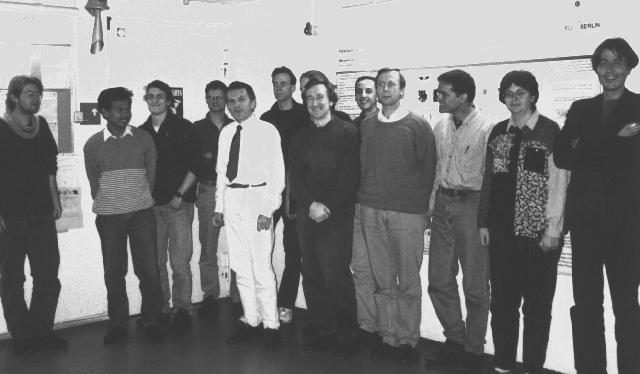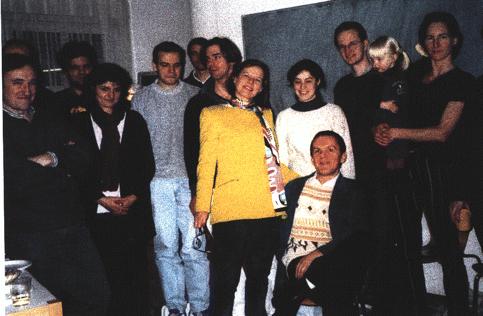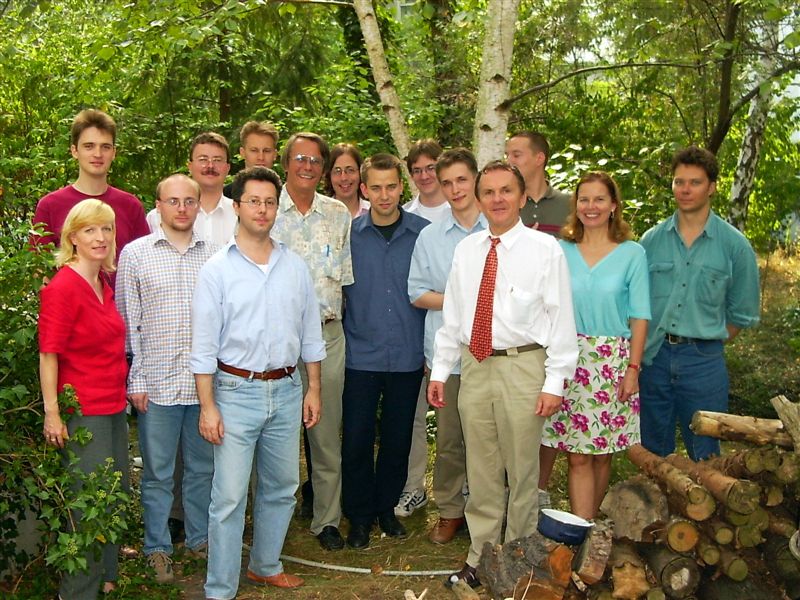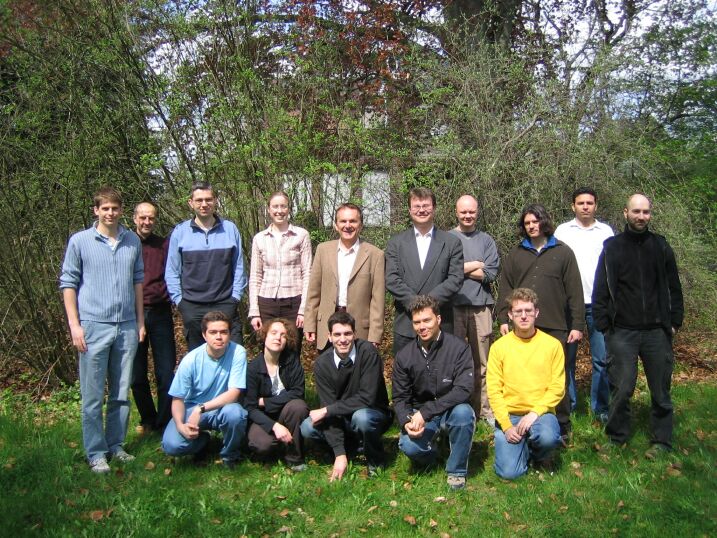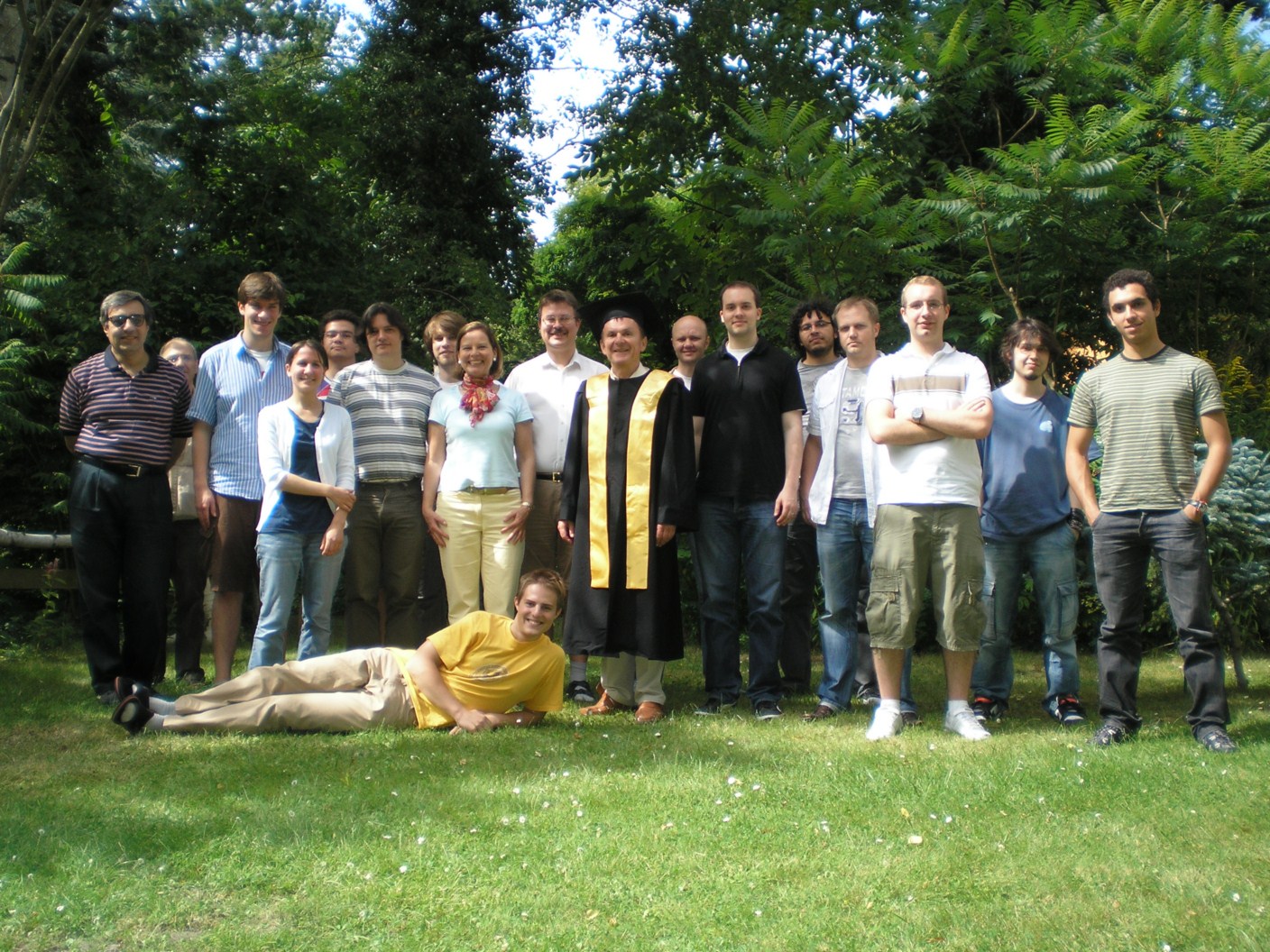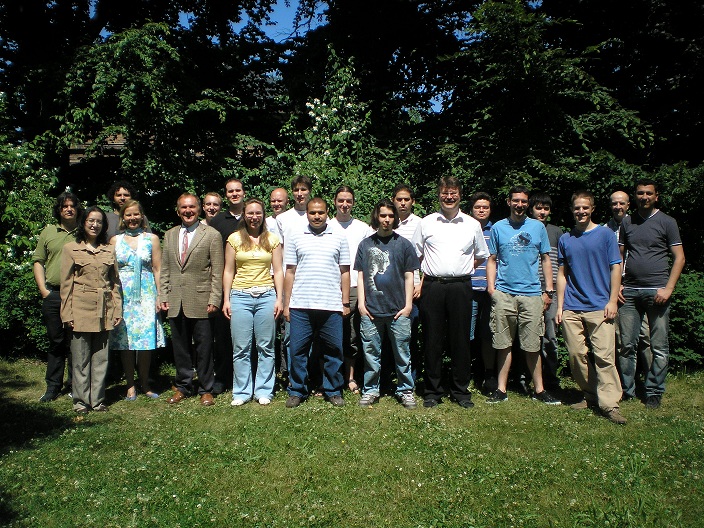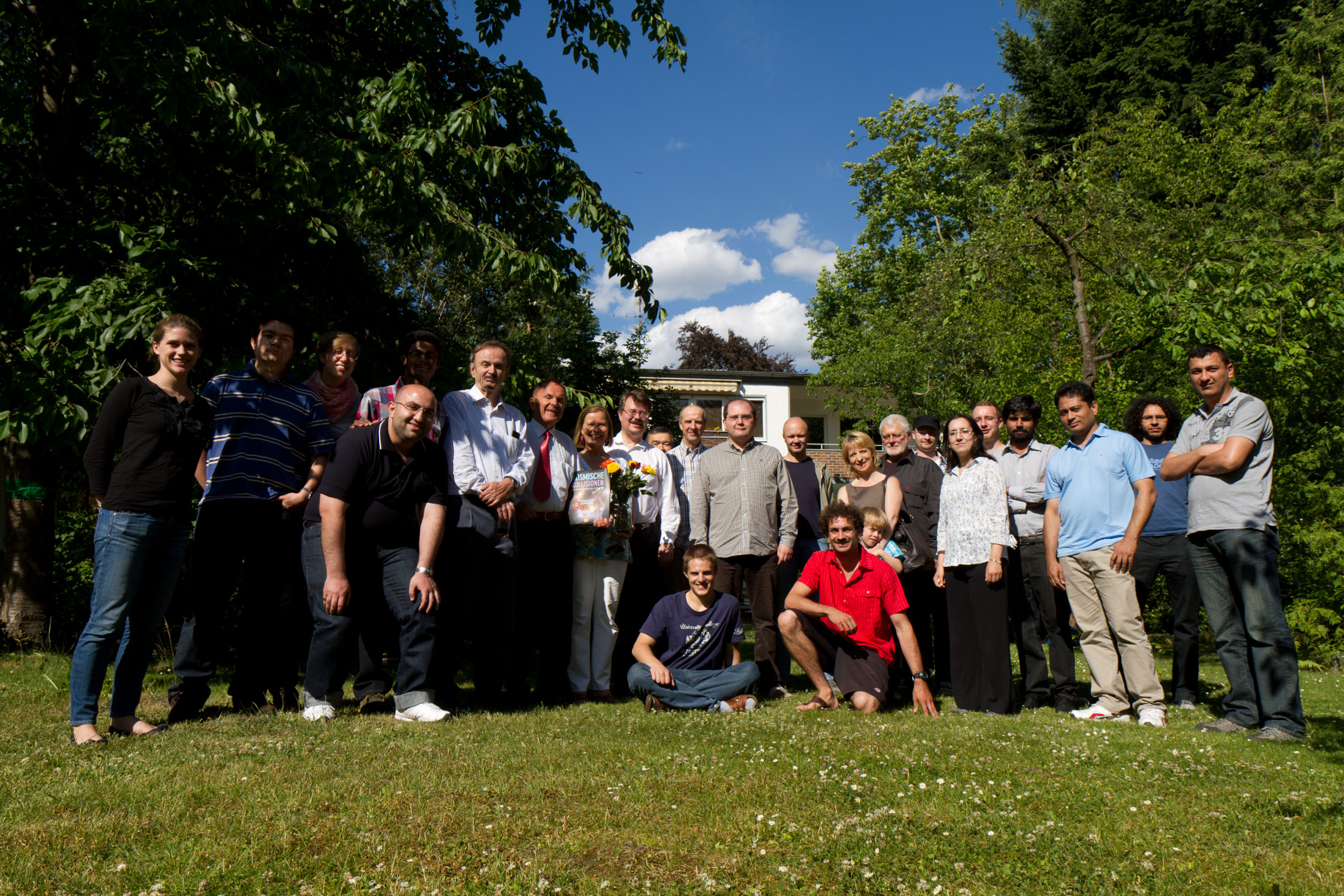
Hagen Kleinert
Life
| Positions: | Professor at Freie Universität Berlin |
| Professor at ICRANet | |
| Author of: | 13 books |
| 418 articles | |
| Networks: | ResearchGate |
| Birthday: | June 15th, 1941 |
| Nationality: | German |
| Married to: | Dr. Annemarie Kleinert, famous researcher in various fields of history |
| Father of: | Dr. Michael Kästner, software architect and experimental physicist |
Prizes and Awards
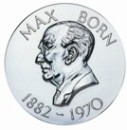
|
Max Born Medal and Prize 2008 |
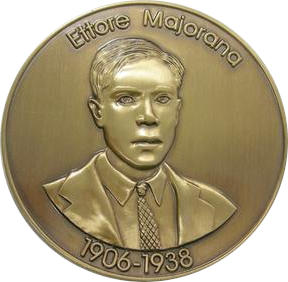
|
Majorana Prize 2008 |
Wikipedia
English Deutsch Español Français Italiano Nederlands Polski Ελληνικά Hrvatski Русский עברית Esperanto Kreyòl ayisyen Српски / srpski Bosanski Latina Magyar Română Čeština العربية تۆرکجه فارسی 中文 日本語 हिन्दी தமிழ்
Books

Collective Classical and Quantum Fields
pp. 1-424, World Scientific, Singapore 2017
ISBN: 978-981-3223-93-6 (hardcover)
ISBN: 978-981-3223-94-3 (softcover)
ISBN: 978-981-3223-96-7 (ebook)
This is an introductory book dealing with collective phenomena in many-body systems. A gas of bosons or fermions can show oscillations of various types of densities. These are described by different combinations of field variables. Especially delicate is the competition of these variables. In superfluid 3He, for example, the atoms can be attracted to each other by molecular forces, whereas they are repelled from each other at short distance due to a hardcore repulsion. The attraction gives rise to Cooper pairs, and the repulsion is overcome by paramagnon oscillations. The combination is what finally led to the discovery of superfluidity in 3He. In general, the competition between various channels can most efficiently be studied by means of a classical version of the Hubbard-Stratonovich transformation.
A gas of electrons is controlled by the interplay of plasma oscillations and pair formation. In a system of rod- or disc-like molecules, liquid crystals are observed with directional orientations that behave in unusual five-fold or seven-fold symmetry patterns. The existence of such a symmetry was postulated in 1975 by the author and K. Maki. An aluminium material of this type was later manufactured by Dan Shechtman which won him the 2014 Nobel prize. The last chapter presents some solvable models, one of which was the first to illustrate the existence of broken supersymmetry in nuclei.

Particles and Quantum Fields
pp. 1-1628, World Scientific, Singapore 2015
ISBN: 978-981-4740-89-0 (hardcover)
ISBN: 978-981-4740-90-6 (softcover)
ISBN: 978-981-4740-92-0 (ebook)
This is an introductory book on elementary particles and their interactions. It starts out with many-body Schrödinger theory and second quantization and leads, via its generalization, to relativistic fields of various spins and to gravity. The text begins with the best known quantum field theory so far, the quantum electrodynamics of photon and electrons (QED). It continues by developing the theory of strong interactions between the elementary constituents of matter (quarks). This is possible due to the property called asymptotic freedom. On the way one has to tackle the problem of removing various infinities by renormalization. The divergent sums of infinitely many diagrams are performed with the renormalization group or by variational perturbation theory (VPT). The latter is an outcome of the Feynman-Kleinert variational approach to path integrals discussed in two earlier books of the author, one representing a comprehensive treatise on path integrals, the other dealing with critial phenomena. Unlike ordinary perturbation theory, VPT produces uniformly convergent series which are valid from weak to strong couplings, where they describe critical phenomena.
The present book develops the theory of effective actions which allow to treat quantum phenomena with classical formalism. For example, it derives the observed anomalous power laws of strongly interacting theories from an extremum of the action. Their fluctuations are not based on Gaussian distributions, as in the perturbative treatment of quantum field theories, or in asymptotically-free theories, but on deviations from the average which are much larger and which obey power-like distributions.
Exactly solvable models are discussed and their physical properties are compared with those derived from general methods. In the last chapter we discuss the problem of quantizing the classical theory of gravity.

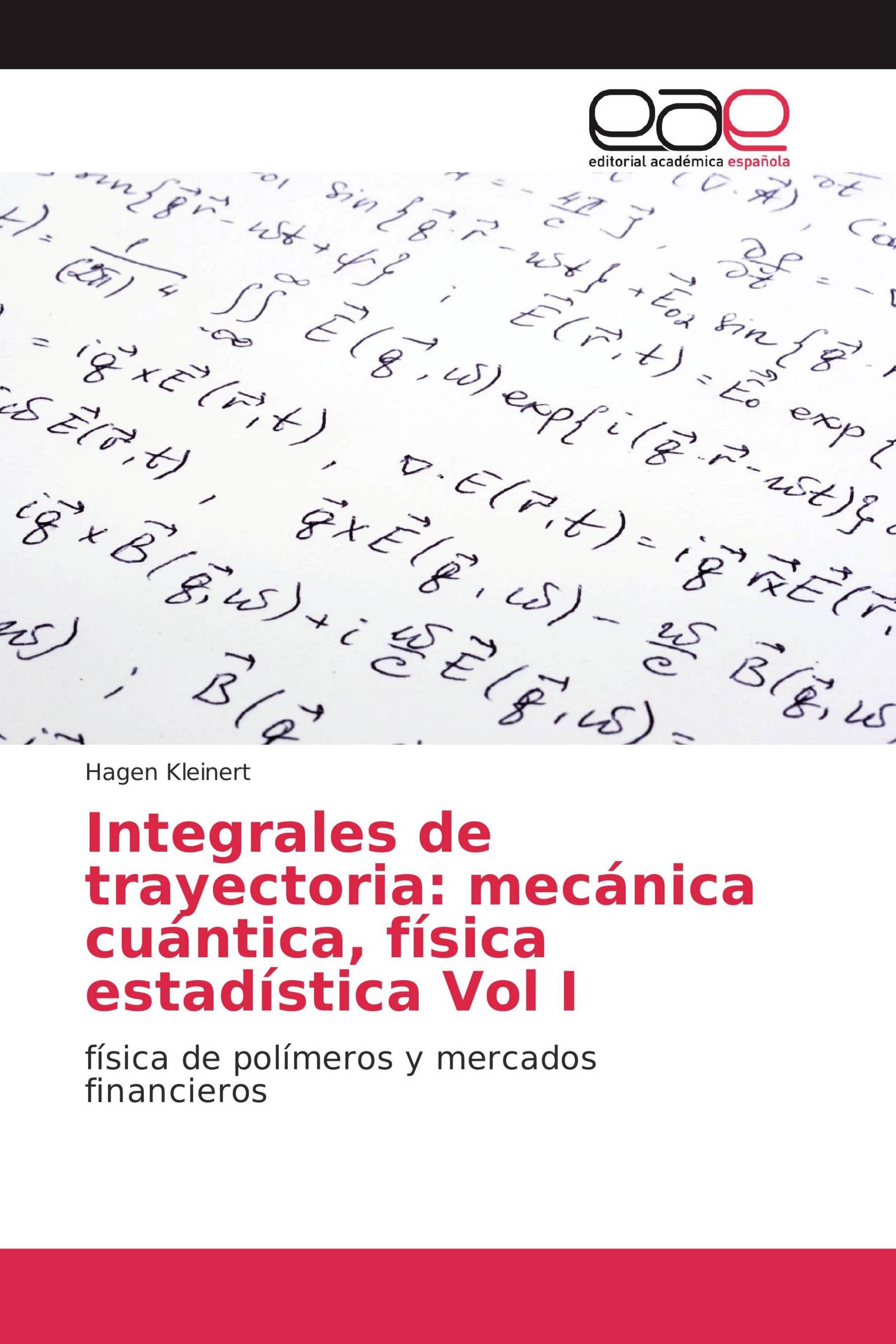
Path Integrals
5th edition, pp. 1-1624, World Scientific, Singapore 2009
ISBN: 978-981-4273-55-8 (hardcover)
ISBN: 978-981-4273-56-5 (softcover)
ISBN: 978-981-4365-26-0 (ebook)
This is the fifth, expanded edition of the comprehensive textbook published in 1990 on the theory and applications of path integrals. It is the first book to explicitly solve path integrals of a wide variety of nontrivial quantum-mechanical systems, in particular the hydrogen atom. The solutions have been made possible by two major advances. The first is a new euclidean path integral formula which increases the restricted range of applicability of Feynman's time-sliced formula to include singular attractive 1/r- and 1/r2-potentials. The second is a new nonholonomic mapping principle carrying physical laws in flat spacetime to spacetimes with curvature and torsion, which leads to time-sliced path integrals that are manifestly invariant under coordinate transformations.
In addition to the time-sliced definition, the author gives a perturbative, coordinate-independent definition of path integrals, which makes them invariant under coordinate transformations. A consistent implementation of this property leads to an extension of the theory of generalized functions by defining uniquely products of distributions.
The powerful Feynman-Kleinert variational approach is explained and developed systematically into a variational perturbation theory which, in contrast to ordinary perturbation theory, produces convergent results. The convergence is uniform from weak to strong couplings, opening a way to precise evaluations of analytically unsolvable path integrals in the strong-coupling regime where they describe critical phenomena.
Tunneling processes are treated in detail, with applications to the lifetimes of supercurrents, the stability of metastable thermodynamic phases, and the large-order behavior of perturbation expansions. A variational treatment extends the range of validity to small barriers. A corresponding extension of the large-order perturbation theory now also applies to small orders.
Special attention is devoted to path integrals with topological restrictions needed to understand the statistical properties of elementary particles and the entanglement phenomena in polymer physics and biophysics. The Chern–Simons theory of particles with fractional statistics (anyons) is introduced and applied to explain the fractional quantum Hall effect.
The relevance of path integrals to financial markets is discussed, and improvements of the famous Black–Scholes formula for option prices are developed which account for the fact, recently experienced in the world markets, that large fluctuations occur much more frequently than in Gaussian distributions.
Translations
- Spanish translation by Daniel Olguin (daniel@fis.cinvestav.mx), with the help of Pablo Medina Zepeda (jerzyzepeda@gmail.com).
- Chinese translation by Dr. Cong-Feng Qiao (qiaocf@gucas.ac.cn).
Downloads

Proceedings of the Eleventh Marcel Grossmann Meeting on General Relativity
pp. 1-3120, World Scientific, Singapore 2008
ISBN: 978-981-2834-26-3 (hardcover)
ISBN: 978-981-4470-03-2 (ebook)
The Marcel Grossmann Meetings are three-yearly forums that meet to discuss recent advances in gravitation, general relativity and relativistic field theories, emphasizing their mathematical foundations, physical predictions and experimental tests. These meetings aim to facilitate the exchange of ideas among scientists, to deepen our understanding of space-time structures, and to review the status of ongoing experiments and observations testing Einstein's theory of gravitation either from ground or space-based experiments. Since the first meeting in 1975 in Trieste, Italy, which was established by Remo Ruffini and Abdus Salam, the range of topics presented at these meetings has gradually widened to accommodate issues of major scientific interest, and attendance has grown to attract more than 900 participants from over 80 countries. This proceedings volume of the eleventh meeting in the series, held in Berlin in 2006, highlights and records the developments and applications of Einstein's theory in diverse areas ranging from fundamental field theories to particle physics, astrophysics and cosmology, made possible by unprecedented technological developments in experimental and observational techniques from space, ground and underground observatories. It provides a broad sampling of the current work in the field, especially relativistic astrophysics, including many reviews by leading figures in the research community.
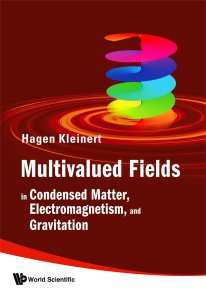
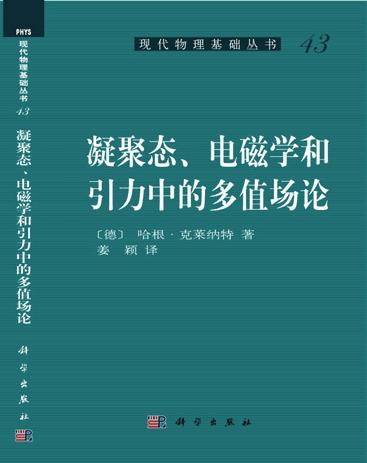
Multivalued Fields
pp. 1-2800, World Scientific, Singapore 2008
ISBN: 978-981-2791-70-2 (hardcover)
ISBN: 978-981-2791-71-9 (softcover)
ISBN: 978-981-3101-34-0 (ebook)
This book lays the foundations of the theory of fluctuating multivalued fields with numerous applications. Most prominent among these are phenomena dominated by the statistical mechanics of line-like objects, such as the phase transitions in superfluids and superconductors as well as the melting process of crystals, and the electromagnetic potential as a multivalued field that can produce a condensate of magnetic monopoles. In addition, multivalued mappings play a crucial role in deriving the physical laws of matter coupled to gauge fields and gravity with torsion from the laws of free matter. Through careful analysis of each of these applications, the book thus provides students and researchers with supplementary reading material for graduate courses on phase transitions, quantum field theory, gravitational physics, and differential geometry.
Translations
- Chinese translation by Dr. Ying Jiang (yjiang@shu.edu.cn).
Downloads
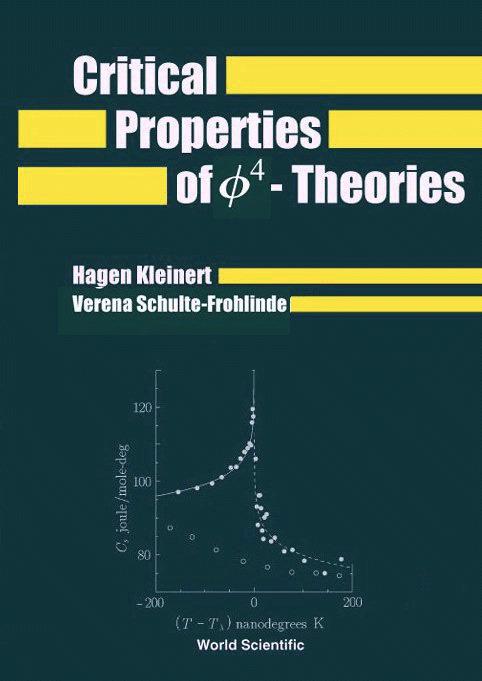
Critical Properties of Phi4-Theories
pp. 1-512, World Scientific, Singapore 2001
ISBN: 978-981-0246-58-7 (hardcover)
ISBN: 978-981-0246-59-4 (softcover)
ISBN: 978-981-4490-79-5 (ebook)
This book explains in detail how to perform perturbation expansions in quantum field theory to high orders, and how to extract the critical properties of the theory from the resulting divergent power series. These properties are calculated for various second-order phase transitions of three-dimensional systems with high accuracy, in particular the critical exponents observable in experiments close to the phase transition.
Beginning with an introduction to critical phenomena, this book develops the functional-integral description of quantum field theories, their perturbation expansions, and a method for finding recursively all Feynman diagrams to any order in the coupling strength. Algebraic computer programs are supplied on accompanying World Wide Web pages. The diagrams correspond to integrals in momentum space. They are evaluated in 4-ε dimensions, where they possess pole terms in 1/ε. The pole terms are collected into renormalization constants.
The theory of the renormalization group is used to find the critical scaling laws. They contain critical exponents which are obtained from the renormalization constants in the form of power series. These are divergent, due to factorially growing expansion coefficients. The evaluation requires resummation procedures, which are performed in two ways: (1) using traditional methods based on Padé and Borel transformations, combined with analytic mappings; (2) using modern variational perturbation theory, where the results follow from a simple strong-coupling formula. As a crucial test of the accuracy of the methods, the critical exponent α governing the divergence of the specific heat of superfluid helium is shown to agree very well with the extremely precise experimental number found in the space shuttle orbiting the earth (whose data are displayed on the cover of the book).
The phi4-theories investigated in this book contain any number N of fields in an O(N)-symmetric interaction, or in an interaction in which O(N)-symmetry is broken by a term of a cubic symmetry. The crossover behavior between the different symmetries is investigated. In addition, alternative ways of obtaining critical exponents of phi4-theories are sketched, such as variational perturbation expansions in three rather than 4-ε dimensions, and improved ratio tests in high-temperature expansions of lattice models.
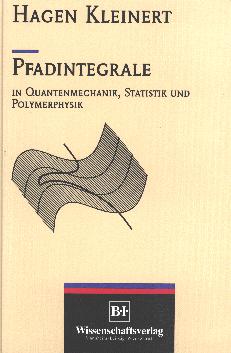
Pfadintegrale
pp. 1-850, Spektrum Akademischer Verlag, Heidelberg 1993
ISBN: 3-86025-613-0 (hardcover)
Dieses umfassende Lehrbuch aber Theorie und Anwendung von Pfadintegralen enthält erstmals Lösungen für eine Vielzahl nichttrivialer Systeme. Darunter fallen das einfachste System der Atomphysik und das für die Gravitationsphysik relevante System eines Teilchens in einem Raum mit Krümmung und Torsion. Ermöglicht werden diese Lösungen durch zwei neue Entwicklungen eine euklidische Pfadintegralformel, die im Gegensatz zur Feynmanschen Formel auch bei attraktiven 1/r- und 1/r2-Potentialen existiert, und ein einfaches Aequivalenzprinzip, die Übertragung von Pfadintegralen aus dem flachen Raum in einen nichteuklidischen Raum regelt. Damit zusammenhängend wird gezeigt, daß die Ableitung der richtigen klassischen Bewegungsgleichungen in Räumen mit Torsion eines Wirkungsprinzips bedarf.
Das Feynman-Kleinert-Variationsverfahren wird vorgestellt und systematisch verbessert. Es ermöglicht eine sehr genaue Berechnung analytisch nicht lösbarer Pfadintegrale.
Eine ausführliche Behandlung erfährt die Theorie der Tunnelprozesse mit Anwendungen auf die Lebensdauer von Supraströmen, die Stabilität metastabiler Phasen und das von Störungsreihen. Mit Hilfe eines neuen Variationsverfahrens wird der bisher auf hohe Tunnelbarrieren eingeschränkte Gültigkeitbereich auf niedrige Barrieren erweitert und vermittelt dadurch Kenntnis aber Störungskoeffizienten niedrigerer Ordnung.
Besondere Aufmerksamkeit gilt Pfadintegralen mit topologischen Einschränkungen, die für die Statistik quantenmechanischer Vielteilchensysteme und Verschlingungserscheinungen in der Polymerphysik von Bedeutung sind. Die Chern-Simons-Theorie der wird eingeführt, ihre mögliche Relevanz für die Hochtemperatur-Supraleitung erläutert und die auf ihr fußende Erklärung des Quanten-Hall-Effekts geliefert.


Gauge Fields in Condensed Matter
This book is the first to develop a unified gauge theory of condensed matter systems dominated by vortices or defects and their long-range interactions. Gauge fields provide the only means of describing these interactions in terms of local fields, rendering them accessible to standard field theoretic techniques. Two particularly important examples, superfluid systems and crystals, are treated in great detail. The theory is developed in close contact with physical phenomena and evolves naturally from conventional descriptions of the systems. In addition to gauge fields, the book introduces the important new concept of disorder fields for ensembles of line-like defects. The combined field theory allows for a new understanding of the important phase transitions superfluid ‘normal and solid’ liquid. Apart from the above, the book presents the general differential geometry of defects in spaces with curvature and torsion and establishes contact with the modern theory of gravity with torsion. This book is written for condensed matter physicists and field theorists. It can be used as a textbook for a second-year graduate course or as supplementary reading for courses in the areas of condensed matter and solid state physics, statistical mechanics, and field theory.
Downloads
Articles
[2] H. Kleinert
Isoscalar Nucleon Form Factor from O(4,2) Dynamics,
Phys. Rev. 163, 1807 (1968)
[3] H. Kleinert
Relativistic Current of the H-Atom in O(4,2) Dynamics,
Phys. Rev. 168, 1827 (1968)
[12] A.O. Barut and H. Kleinert
Transition Form Factors of H-Atom,
Phys. Rev. 160, 1149 (1967)
[36] H. Kleinert
A Model for Deep Inelastic Structure Functions,
Nucl. Phys. B 43, 301-330 (1972)
[39] H. Kleinert
Broken Scale Invariance,
Fortschr. Phys. 21, 1-55 (1973)
[40] H. Kleinert
Algebraization of Regge Couplings,
Phys. Letters B 39, 511-513 (1972)
[44] H. Kleinert
Algebra of Regge Residues,
Lettere Nuovo Cimento 6, 583 (1973)
[45] H. Kleinert
Bilocal Form Factors and Regge Couplings,
Nucl. Phys. B 65, 77-111 (1973)
[47] H. Kleinert
Quarks and Reggeons,
Nucl. Phys. B 79, 526-545 (1974)
[50] H. Kleinert
Quark Pairs inside Hadrons,
Phys. Letters B 59, 163 (1975)
[51] H. Kleinert
Quark Masses,
Phys. Letters B 62, 77 (1976)
[61] H. Kleinert
The Two Superflows in ^3He-A,
Phys. Lett. A 71, 66 (1969)
[63] H. Kleinert
Collective Field Theory of Superliquid ^3He,
FU-Berlin preprint, 1978
[80] H. Kleinert
Beyond Landau's Theory of Fermi Liquids,
Phys. Letters A 84, 202 (1981)
[82] H. Kleinert
Higher Effective Actions in Bose Systems,
Fortschr. Phys. 30, 187 (1982)
[85] H. Kleinert
No Cryptoferromagnetic State due to Fluctuations,
Phys. Lett. A 83, 294(1981)
[86] H. Kleinert
Restrictions on Pion Condensate,
Lett. Nuovo Cimento 34, 133 (1982)
[88] H. Kleinert
Gauge Theory of Dislocation Melting,
Phys. Lett. A 89, 294 (1982)
[90] H. Kleinert
Towards a Unified Theory of Defects and Stresses,
Lett. Nuovo Cimento 35, 41 (1982)
[91] H. Kleinert
Defect Melting as an SO(3) Lattice Gauge Theory,
Phys. Lett. B 113, 395 (1982)
[92] H. Kleinert
A New Dynamical Origin for Higgs Particles,
Lett. Nuovo Cimento 34, 209 (1982)
[93] H. Kleinert
Duality Transformation for Defect Melting,
Phys. Lett. A 91, 295 (1982)
[94] H. Kleinert
Line-like Defects in Pion Condensate,
Lett. Nuovo Cimento 34, 103 (1982)
[101] H. Kleinert
Transition Entropy of Defect Melting,
Phys. Lett. A 95, 493 (1983)
[105] H. Kleinert
Dual Model of Dislocation and Disclination Melting,
Phys. Lett. A 96 302 (1983)
[106] H. Kleinert
Limitations on Coleman-Weinberg Mechanism,
Phys. Lett. B 128, 69 (1983)
[107] H. Kleinert
Double Gauge Theory of Stresses and Defects,
Phys. Lett. A 97, 51 (1983)
[109] H. Kleinert
Model of Glass,
Phys. Lett. A 101, 224 (1984)
[111] S. Ami and H. Kleinert
Fluctuations in 2D Melting,
J. Phys. Lett. 45, (Paris) 877 (1984)
[120] W. Janke and H. Kleinert
First Order in 2D Disclination Melting,
Phys. Lett. A 105, 134 (1984)
[126] W. Janke and H. Kleinert
How Good is the Villain Approximation?
Nucl. Phys. B 270, 135 (1986)
[129] H. Kleinert
Size Distribution of Spherical Vesicles,
Phys. Lett. A 116, 57 (1986)
[137] H. Kleinert
Microemulsions in the Three-Phase Regime,
J. Chem. Phys. 84, 964 (1986)
[149] H. Kleinert
The Membrane Properties of Condensing Strings
Phys. Lett. B 174, 335 (1986)
[152] S. Ami and H. Kleinert
Functional Measures of Membrane Fluctuations,
FU-Berlin preprint 1986.
[158] H. Kleinert
Floppy Membranes,
FU-Berlin preprint 1986.
[160] H. Kleinert
Quark Mass Dependence of 1/R Term in String Potential,
[163] H. Kleinert
How to do the Time-Sliced Path Integral of H-Atom,
Phys. Lett. A 120, 361 (1987)
[165] H. Kleinert
Spontaneous Quantum Gravity - A Soluble Model
Phys. Lett. B 196, 355 (1987)
[166] H. Kleinert
Spontaneous Strings
FU-Berlin preprint 1987.
[167] H. Kleinert
Glueballs from Spontaneous Strings
Phys. Rev. D 37, 1699 (1988)
[169] H. Kleinert
Phases of Spontaneous Strings in Large Dimensions
Phys. Lett. B 197, 125 (1987)
[177] H. Kleinert
Dynamical Generation of String Tension and Stiffness
Phys. Lett. B 211, 151(1988)
[178] H. Kleinert
Solution of Dyson Equation For Elastic Membranes
J. Math. Phys. 30, 2991 (1989)
[181] H. Kleinert
Membrane Stiffness from v.d. Waals forces
Phys. Lett. A 136, 253(1989)
[210] H. Kleinert
Improving the Variational Approach to Path Integrals
Phys. Lett. B 280, 251 (1992)
[353] H. Kleinert
Travailler avec Feynman
Pour La Science 19, 89-95 (2004) (see also here)
[366] H. Kleinert
Field Transformations and Multivalued Fields
Berlin preprint 2006
[367] H. Kleinert
Stiff Quantum Polymers
Phys. Rev. B 76, 052202 (2007) (arXiv:cond-mat/0701030v3)
[390] A. Karamatskou and H. Kleinert
Quantum Maupertuis Principle
(quant-ph/0910.4034)
[392] H. Kleinert
Strong-Coupling Bose-Einstein Condensation
(cond-mat/1105.5115)
[393] H. Kleinert
Extending Bogoliubov's Boson Theory to Strong Couplings
preprint 2011
[398] H. Kleinert
Quantum Field Theory of Particle Orbits with Large Fluctuations
(preprint)
[400] H. Kleinert
Superpositions of probability distributions
Phys. Rev. E 78, 031122 (2008)
[409] H. Kleinert
Quantum Field Theory of Black-Swan Events
Found. Phys. 44, 546 (2014).
[414] H. Kleinert,
The GIMP Nature of Dark Matter
Berlin preprint (2016), EJTP 13 (2016) 1-12
Fields of Research
Introduction
A large variety of physical systems can be decribed in a unified way with the help of quantum field theory. The fields represent fluctuating physical quantities such as atomic positions, electric and magnetic fields, directions of molecules, etc., at each spacetime point. The materials can be solids, liquids, liquid crystals, or nuclei. Fields can also be used to study the changing shapes of membranes which are formed by bilipids or detergents in biophysics and chemical physics.
Field fluctuations are described most efficiently with the help of functional integrals, which form a common mathematical framework for explaining the phenomenon encountered in such systems. This description leads to a universal understanding of all continuous phase transitions. It also renders important insights into discontinuous transitions, such as the melting transition of crystals.
The research of this group is devoted to applying the functional techniques to novel systems. The purpose is to improve the available mathematical methods whenever necessary. Parallels are established with the theory of elementary particles.
1. Theory of Defect-Induced Phase Transitions
Solids and superfluids undergo phase transitions which can be explained by the large configurational entropy of line-like defects or vortex lines. In contrast to Landau's order field theory of phase transition, a powerful new disorder field theory has been developed in the textbook Gauge Fields in Condensed Matter. There it is shown that the long-range forces between the line structures can conveniently be described by a gauge theory. This makes the ensuing disorder field theories structurally very similar to the well-known Ginzburg-Landau theory of superconductivity, which is advantageous for extracting the physical consequences.
2. Quark Confinement and String Physics
Quarks are held together by color-electric flux tubes. Their formation can be studied best in a dual formulation of the Abelian Higgs model developed in my Book 1, and further in the Theory of Quark Confinement developed in Refs. 203, 205, 211.
The properties of the flux tubes are investigated with the help of a string model with curvature stiffness, which was first proposed by us (Ref. 149) and, independently, by A. M. Polyakov. The paper has instigated much research elsewhere. We have found that contrary to earlier expectations, the color-electric flux tube formed between a quark and an antiquark has a negative stiffness (Ref. 241).
A new model was found which has this property and, in addition, a smooth phase without the undesirabel phenomenon of "plumber's nightmare" (Ref. 276).
3. Quantum Mechanics
A new variational approach to path integrals developed in collaboration with R.P. Feynman (Ref. 159, see also here) has been extended systematically and has lead to exponentially fast convergent perturbation expansions. (Ref. 213, 220, 229 and Book 4). A further recent discovery is a variational approach to tunneling processes (Refs. 214, 221, 231). This help improving resummation techniques for divergent perturbation series (Refs. 228, 220).
It has led to the most precise theoretical predictions of the critical properties of statistical systems near phase transitions. See details the Path Integrals in Quantum Mechanics, Statistics, and Polymer Physics , which has appeared in German under the title Pfadintegrale in Quantenmechanik, Statistik und Polymer Physics, B.I.-Wissenschaftsverlag, Mannheim, 1993 (Book 4). A nonholonomic mapping principle was found by which the laws quantum physics in spaces with curvature and torsion can be determined from the known laws in euclidean space by a nonholonomic mapping (Refs. 199, 202, 258; Path Integrals, Chapters 10, 11).
4. Classical and Statistical Mechanics in Spaces with Curvature and Torsion
The quantum equivalence principle necessitates the study of its classical limit. A surprising result was that the action principle for the derivation of the equations of motion is changed in an essential way with respect to previous formalisms if a space carries torsion (Ref. 219). As applications of the new action principle, we have derived correctly the Euler equations of motion of a rigid body in the body-fixed coordinate frame (Ref. 224). We have also derived the Fokker-Planck equation governing the Brownian motion of a particle in a space with curvature and torsion which determines the diffusion of classical particles through crystals with defects (Ref. 233).
5. Classical Statistics
The mechanism by which continuous phase transitions in systems with line-like excitations (such as vortex or defect lines) become first-order has been explained with the help of disorder fields (Refs. 131, 194; Books 1 and 2).
An important example is the melting transition, where we have found the first model undergoing two successive continuous melting transitions (Refs. 174, 179; Books 1 and 2).
6. Quantum Statistics
The above variational approach is being used to develop very accurate approximations to quantum statistical partition functions and particle densities (see Chapter 5 in Path Integrals). The operator quantum Langevin equation has been derived for the first time from the forward-backward path integral approach (Ref. 230).
Field Theory of Critical Phenomena The universal critical exponents at a second-order phase transition can be studied by renormalization group techniques. Our group was the first to determine exactly, in collabotration with a Russian group, the epsilon expansion of an O(N)-symmetric phi^4-theory up to five loops (Ref. 208). Also the asymmetric case was solved (Ref. 225). The variational approach to quantum mechanics was extended to quantum field theory resulting in a fully-fledged strong-coupling quantum field thory. This has led to a novel approach to critical phenomena with extremely accurate results for critical exponents, without use of the renormalization group (Refs. 257, 263, 275, 290). The new theory was so successful that it led to Book 6.
7. Polymer Physics
A field theory is under construction to solve the entanglement problem of polymer physics. For a first formulation see the above textbook on Path Integrals.
8. Field Theory of Liquid Crystals
Smectic, nematic, and cholesteric liquid crystals possess interesting phase transitions which are studied by field theoretic techniques. A disorder field theory opens new perspectives for understanding the transition (Ref. 102). A quasicrystalline phase with icosahedral structure was theoretically proposed by us 3 years before the experimental discovery of such a material (Ref. 75). Click here, for more details .
Discovery of Quasicrystals; Icosahedral Phase
The existence of quasicrystals in an icosahedral phase was first conjectured and investigated in 1981 as a candiate for the blue phase in liquid crystals by
A phase with these properties was discovered experimentally three years later by Shechtman at al. in 1984: D. Shechtman at al., Phys. Rev. Lett. 53, 1951 (1984) in a rapid solidification of the alloy Al86Mn14.
Shechtman's experimental discovery earned him the Nobel Prize 2011 for a "Paradigm Shift in Crystallography" . Chemists had a hard time believing in the existence of a five-fold symmetric crystal structure discussed in our 1981 paper with Maki.
See also the citations of Kleinert and Maki in the review article on Liquid Crystals by
Tamar Seideman.
A picture of the square of the icosahedral order parameter in Eq. (4,22) of above Kleinert
and Maki paper can easily be plotted with the help of this short Mathematica script:
nfold=5;
k[n_]:=2 Pi *n/nfold
phi=Sum[E^(I (Cos[k[n]]*x+Sin[k[n]]*y)),{n,0,nfold-1}]
ContourPlot[Abs[phi]^2,{x,-60,60},{y,-60,60}]

By changing the number nfold, the program draws a picture of the density of other two-dimensional quasicrystal symmetries, for instance a picture of the nfold=7 heptagonal order parameter:
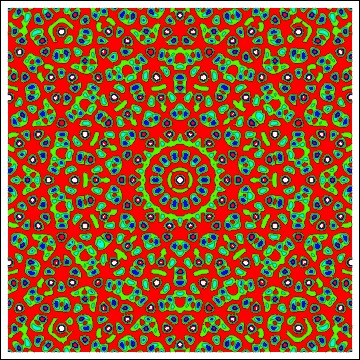
9. Fluctuation Effects in Membranes
Many physical systems contain flexible membranes. Examples are red blood cells, soap layers between oil and water, and bilipid vesicles. The phase transition in such systems are studied via a suitably constructed field theory. The universal constant in the pressure law of an ideal gas of layered membranes was first determined by us with great precision via Monte Carlo calculations (Refs. 133, 143, 184), and recently analytically (225). An experimentally-observed spiky superstructure on membranes was found theoretically (266).
10. Superfluid Helium 3
Functional methods have been used to develop a theory of the long-wavelength phenomena in superfluid Helium 3 on the basis of collective fields (Ref. 55). A new texture was discovered theoretically (Ref. 59) and found later experimentally (Refs. 133, 143, 184).
11. Superconductivity
A disorder field theory was developed for superconductors in Refs. 97, 98, 1, and has allowed us to predict a tricritical point in the superconducting phase transition which was confirmed recently by Monte Carlo simulations. It has also permitted a first determination of the critical exponents of the transition (Ref. 226).
12. Mathematical Physics
Exact solution methods are developed for path integrals. The most prominent method was found in 1979 in collaboration with Duru (Refs. 65, 83). It has meanwhile led to the solution of many path integrals which previously appeared unsolvable (Book 11). Recent examples are the path integrals for a point particle on spherical surfaces and on group spaces (Ref. 202), as well as for the relativistic Coulomb system (Ref. 232). Another important result obtained in mathematical physics is the solution of the problem of defining products of distributions such as delta- and Heaviside functions. It results from the requirement of invariance of path integrals under coordinate tranformations. This is necessary for the equivalence to Schroedinger theory. This fixed all products of distributions, as shown in Ref. 303. The result is the same as can be found from dimensional resularization (see Ref. 305, also Chapter 10 of the textbook on Path Integrals).
13. Stochastic Physics
The powerful Duru-Kleinert method for solving path integrals is being extended to Markov processes. In collaboration with A. Pelster, a transformation has been found in Ref. 249, by which Fokker-Planck equations of different Markov processes can be transformed into each other. This allows us to relate unsolved to solved problems, and may the key to finding solutions for many as yet untackled equations.
14. Supersymmetry in Nuclear Physics
Nuclear spectra show broken supersymmetry as was first pointed out by us in the 1978 Erice School on The New Aspects in Nuclear Physics. For details see here.
15. Financial Markets
Path integrals are a powerful tool for studying fluctuations in financial markets which are non-Gaussian. The traditional assumption of Gaussian distribution severely underestimates the probability of large jumps in asset prices and this was the main reason for the catastrophic failure in the early fall of 1998 of the hedge fund Long Term Capital Investment, which had the Nobel price winners Scholes and Merton on the advisory board (and as shareholders). The fund contained derivative with a notional value of 1,250 Billion US$. The fund collected 2% for administrative expenses and 25% of the profits, and was initially extremely profitable. It offered its shareholders returns of 42.8% in 1995, 40.8% in 1996, and 17.1% even in the disastrous year of the Asian crisis 1997. But in September 1998, after mistakenly gambling on a convergence in interest rates, it almost went bankrupt. A number of renowned international banks and Wall Street institutions had to bail it out with 3.5 Billion US$ to avoid a chain reaction of credit failures. Starting from a path integral formulation, we have developed a generalization of Ito's stochastic calculus to non-Gaussian fluctuations (Ref. 329) and derived a new option pricing formula from this (Ref. 333). A detailed theory is contained in my textbook on path integrals.
Theories
- Path Integrals in Quantum Mechanics, Statistics, and Polymer Physics
- Duru-Kleinert Transformation for Exact Solution of Path Integrals
- Feynman-Kleinert Variational Approach (see Collaboration with R.P.Feynman)
- Disorder Field Theory of Phase Transitions
- Dual Theory of Superconductivity
- Five-Loop Calculation of Critical Exponents in 4-epsilon Dimensions
- Strong-Coupling Theory of Critical Behavior (more here)
- Kleinert Criterion for Onset of Phase Decoherence
- Variational Perturbation Theory for Field Theory with Anomalous Dimensions turning Divergent Weak-Coupling to Convergent Strong-Couling Expansions
- Vortex Gauge Field Theory of Superfluid Phase Transition
- Defect Gauge Field Theory of Crystal Melting
- Monopole Gauge Field Theory of Confinement
- Collective Quantum Fields in Superconductors and Superfluid He3
- Hadronization of Quark Theories
- Polyakov-Kleinert Stiff String
- Pressure Constant for Stacks of Membranes
- Most Accurate Specific Heat Exponent alpha of Superfluid Helium
- Algebra of Regge Couplings
- Group Dynamics of Hydrogen Atom [the group O(4,2)]
-
Supersymmetry in Nuclear Physics
Discovery of Supersymmetry in Nuclei
There is experimental evidence for supersymmetry in nuclei (see citations below). Its existence (in broken form) was first proposed by Hagen Kleinert during a discussion session after a lecture of Sergio Ferrara on Supersymmetric Theories of Fundamental Interactions held at the 1978 Erice School. It is published in:
The New Aspects of Subnuclear Physics , Plenum Press, N.Y., 1980 (ed. by A. Zichichi), pp. 1--37., pp. 39--58.
The discussion sessions are reprinted on pp. 39--58.It documents that upon a question posed by the Yale student Yuan K. HA (now professor at Temple University), whether there could be supersymmetry in nuclei, was answered affirmatively by Kleinert who pointed out that a simple model of even and odd nuclei exhibits broken supersymmetry. Kleinert had previously presented auch a model at the 1977 Erice Summer School on Low Temperature Physics for a different purpose [lecture is published under the title Collective Quantum Fields, Fortschr. Physik 26, 565-671 (1978). (Start to read at bottom page 5)].
Discussion manuscript, Erice 1978
Experimental Evidence
For experimetal evidence of supersymmetry in nuclei see:
Nuclear structure of 196Au: More evidence for its supersymmetric description, J. Groeger et al., Physical Review C 62, 643044 (2000) - New Stochastic Calculus for Non-Gaussian Processes
- Financial Markets---Option Pricing for Non-Gaussian Price Fluctuations
-
A World Crystal
World Crystal
The World Crystal was proposed as a toy model of the universe in the paper:
It is supposed to illustrate that curvature and torsion may arise from defects and that the universe may have a short-distance structure which may completely surprise us when we shall be able to do experiments at Planck distances. More is explained in the textbook.
The Italian artist Laura Pesce was inspired by the theory and created three glass paintings of the world crystal.
- One of these can be seen on the home page of the artist. The Italian title (Mondo Cristallizzato) can be seen on this page (picture lower left corner).
- A second picture of the world crystal can be seen here on the photo with the artist on this page (photo on the right).
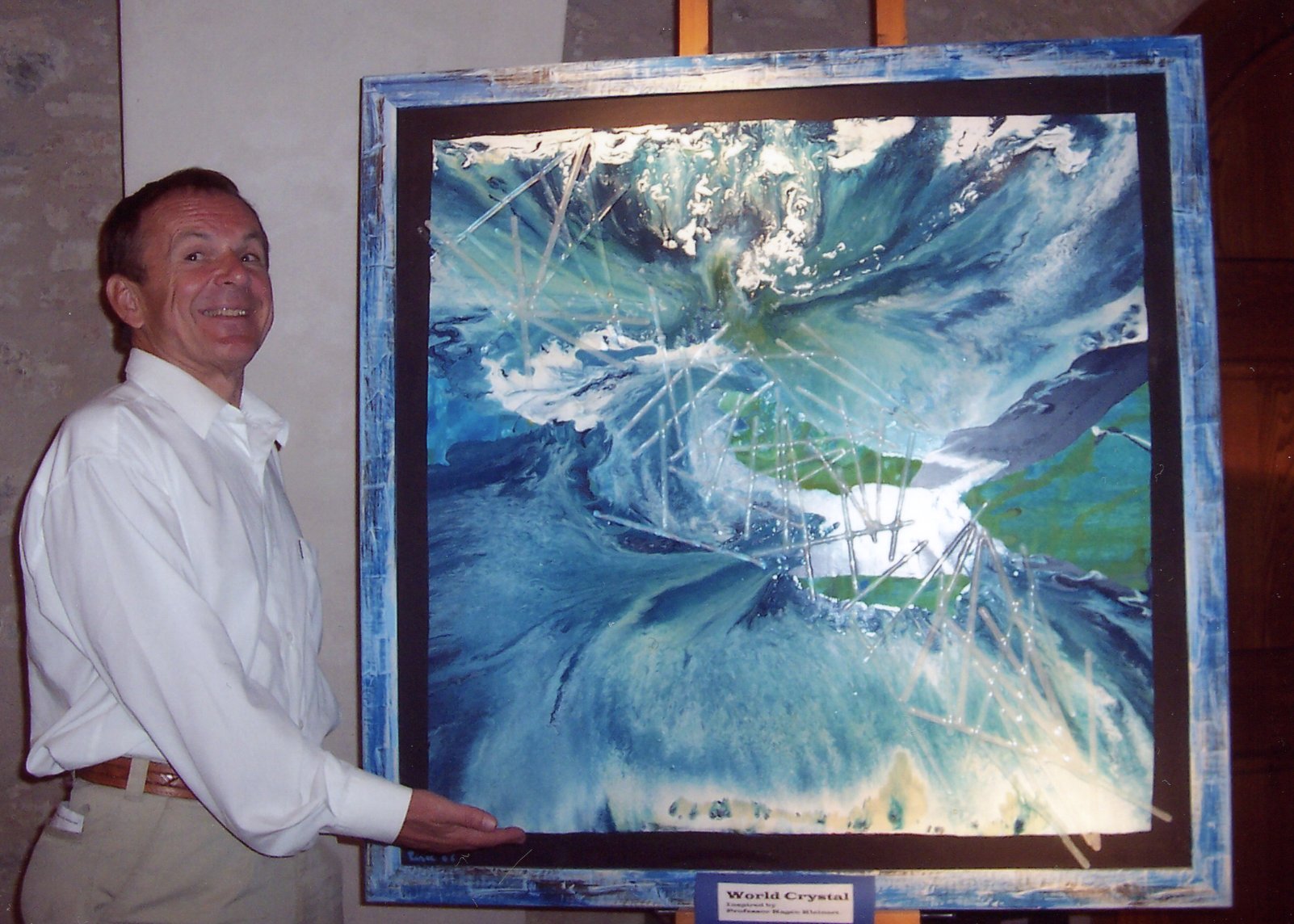
-
No-Go Theorem for Tachyons
No-Go Theorem for tachyons
A physical theory cannot have any tachyon. A propagator has at a nonzero value of q2 a pole implies the existence of particle moving with a velocity faster than light, a so-called tachyon. The possible existence of such states was conjectured for a long time since it was an allowed state in an irreducible representation of the Poincare group. They were an imporant output of infinite-component wave equations which were a popular subject of study in the sixties. See for example this paper. They also exist in the best existing quantum field theory so far, the quantum electrodynamics of electrons and photons (QED).
The textbook can be read online here. There they appear at very large masses which lie far above the validity of this theory. They are called Landau ghosts. They also appear in attempts to quantize gravity by making it emerge from a conformally invariant action.
At the end of Chapter 18 of the above book a no-tachyon theorem is stated as follows:
A particle moving faster then light is removed in nature by the system undergoing a phase transition to a state of lower energy. In field theory this is usually a state with another vacuum expectation value of the fields. This is the typical way how nature deals with all unstable physical systems: For example, a timber-framed house will be unstable if its small vibrations have some eigenfrequency with a negative square value. Upon a small vibration, the amplitudes of such oscillations grow large exponentially fast in time. As a consequence, the structure will collapse into a state of lower energy. If there is again a negative square frequency, the intermediate state will collapse again. This process will go on until the stucture has settled as a stable ruin. In the ruin, all frequencies have positive square values, and no tachyon is left. - Dark Matter and GIMPs
Collaboration with R.P. Feynman at Caltech
Richard Feynman was one of the most fascinating characters of the 20th century, both as a physicist and as a person. My friendship with him had a rather slow start, mostly due to the respect he inspired to me and the other young people around him. I met him first in 1973 when spending a sabbatical winter semester at Caltech. I was invited by Murray Gell-Mann after he had heard a lecture of mine on Current Algebra at a winter school in Schladming, Austria (reporting on the results of a paper I had written at CERN, Geneva).
Caltech was an extremely exciting place. The theory department met every Wednesday for a luncheon seminar where everyone had a chance of presenting his problems and solutions. At that time, experimentalists had discovered point-like constituents in hadrons with the help of deep inelastic scattering of electrons. The point-like structure had been explained phenomenologically by Feynman with his parton model. Gell-Mann was trying to go further by constructing a fundamental quantum field theory which would combine the point-like structure with well-known results of his Current Algebra. So he gave partons the quantum numbers of quarks and described them by fundamental fermion fields. Together with Harald Fritzsch he had just shown that currents constructed from free quark fields would explain most of the data. What was missing at that time was an explanation why free fields worked so well although nobody was able to detect quarks as particles in the laboratory! The model had, however, an important weakness, as was immediately noticed by Feynman: It did not account for the fact that high-energy collisions produced jets of particles --- the free-quark model would lead to uniform distributions. It was Gell-Mann who realized that local color gauge fields could provide them with the necessary glue to keep them forever inside the hadrons. The point-like structure was assured by what is called asymptotic freedom of color gauge theory, which ensures that quarks inside hadrons would behave almost like free particles. This property had just been discovered independently by 't Hooft, Politzer, and by Gross and Wilczek.
Unfortunately, I did not participate in this fundamental endeavor since I was working on a field-theoretic derivation of the Algebra of Regge Residues (see also here), which had been postulated seven years earlier on phenomenological grounds by Cabibbo, Horwitz, and Ne'emann [Phys. Lett. 166, 1786 (1968)]. I found a derivation by generalizing Current Algebra to an algebra of bilocal quark charges of free quark fields. In fact, Yuval Ne'eman [who had discovered in 1961, simultaneously with Gell-Mann, the fact that mesons and nucleons occur in multiplets representing the symmetry group SU(3) and who became later Israel's Minister of Science and development (1982--1984) and of Energy (1990--1992)] was my office mate at Caltech in 1980 and was very happy about my derivation. We became close friends, and whenever he appeared on a ministerial visit in Berlin, he always found some spare time to meet me and discuss physics (protected by several body guards sitting at the tables around us).
Gell-Mann, however, convinced me that according to my derivation, the algebra was not exact but only approximately true due to logarithmic corrections. This made it uninteresting to him. He always said "Don't waste your time with theories which do not have a chance of being true.". He taught me that theories which are only approximate from the beginning are not worth pursuing.
This was quite different with Feynman who loved simple models which can explain things approximately. Feynman appeared regularly at the seminars, and it was an experience to witness the pointed discussions evolving between him and Gell-Mann. There was always a tension between them, a certain rivalry, which led to interesting exchanges. Some of them were plainly silly: for instance, a speaker said on the blackboard: "I am now using Feynman's parton model" and was interrupted by Gell-Mann with the provocative question "What's that?" (whose answer he knew, of course). Feynman responded with a boyish smile: "It's published"! Upon which Gell-Mann said "You mean that phenomenological model which I superseded with my quark field theory?".
The students thoroughly enjoyed seeing the greatest physicists of that time fighting like kids.
In this environment I had the opportunity of participating in a series of seminars Feynman gave to graduate students and postdocs on path integrals with applications to quantum electrodynamics. He told us that when he had first come to Caltech as a young professor he had used path integrals quite extensively in his course on quantum mechanics. Later, however, he had given up on this since he was tired of confessing to the students that he was unable solve the path integral of the most fundamental atomic system, the hydrogen atom, whose solution is so easy in Schrödinger wave mechanics. Feynman knew that I had developed the group theory of the hydrogen atom in my 1967 Ph. D. Thesis, so he challenged me to try my luck with the path integral. We tried a number of things on the blackboard which, however, did not lead to anything.
When I returned home to Berlin in spring 1974 the problem stuck in my head while I was working out my 1976 Erice Lecture "On the Hadronization of Quark Theories" [in which I calculated the mass differences between current and constituent quarks and various current algebra relations]. The hydrogen atom sufaced again in 1978 when a Turkish postdoc, H. Duru, came to me as a Humboldt fellow. He was familiar with my thesis, so I told him Feynman's challenge, and we began searching for the solution. It turned out that Feynman's definition of path integrals as a product of a large but finite number of ordinary integrals was in principle unable to describe the hydrogen atom. The situation is similar to ordinary integrals: if a function is too singular, these can not be approximated by finite sums. We published the solution in 1979, and it became the basis for solving all path integrals whose Schrödinger equation can be solved analytically (see my textbook on this subject).
This success encouraged me to loose my shyness when meeting Feynman again on another sabbatical which I spent mostly in Santa Barbara in 1984. I frequently drove to Pasadena, and met with him to discuss physics, and he always had time for me. We talked for a few hours and usually went to a diner to have a soup together. He was sometimes very funny. Once he said conspiratively to me: "Hagen, I know you have a loose mouth. I shall show you a secret, but only if you promise to tell it to everybody." I did, and he pulled out a photo which showed him in a huge bathtub with three(!) beautiful long-haired California beauties in his arms.
His office had a wall full of tightly filled notebooks which he occasionally pulled one to show me some calculations he had done earlier on the topic we were discussing. He showed me, in particular, long calculations which had not produced any interesting results so far. I still possess a copy of such notes where he calculated the properties of an analog of a polaron, where the role of the particle coupled to phonons is played by a spin. He always wanted me to find a nice physical system where his model could be applied, but I did not succeed. He put a message to his secretary Helen Tuck to send me these notes on his blackboard, which remained there until he died in February 1989. It is visible in Fig. 1a: "Feynman's last blackboard" in the February issue of Physics Today in 1989, page 88. The relevant section of the blackboard is pictured in Fig. 1. Right bottom shows note to his secretary Helen Tuck asking her to send his calculations on self-coupled spin system to Kleinert.
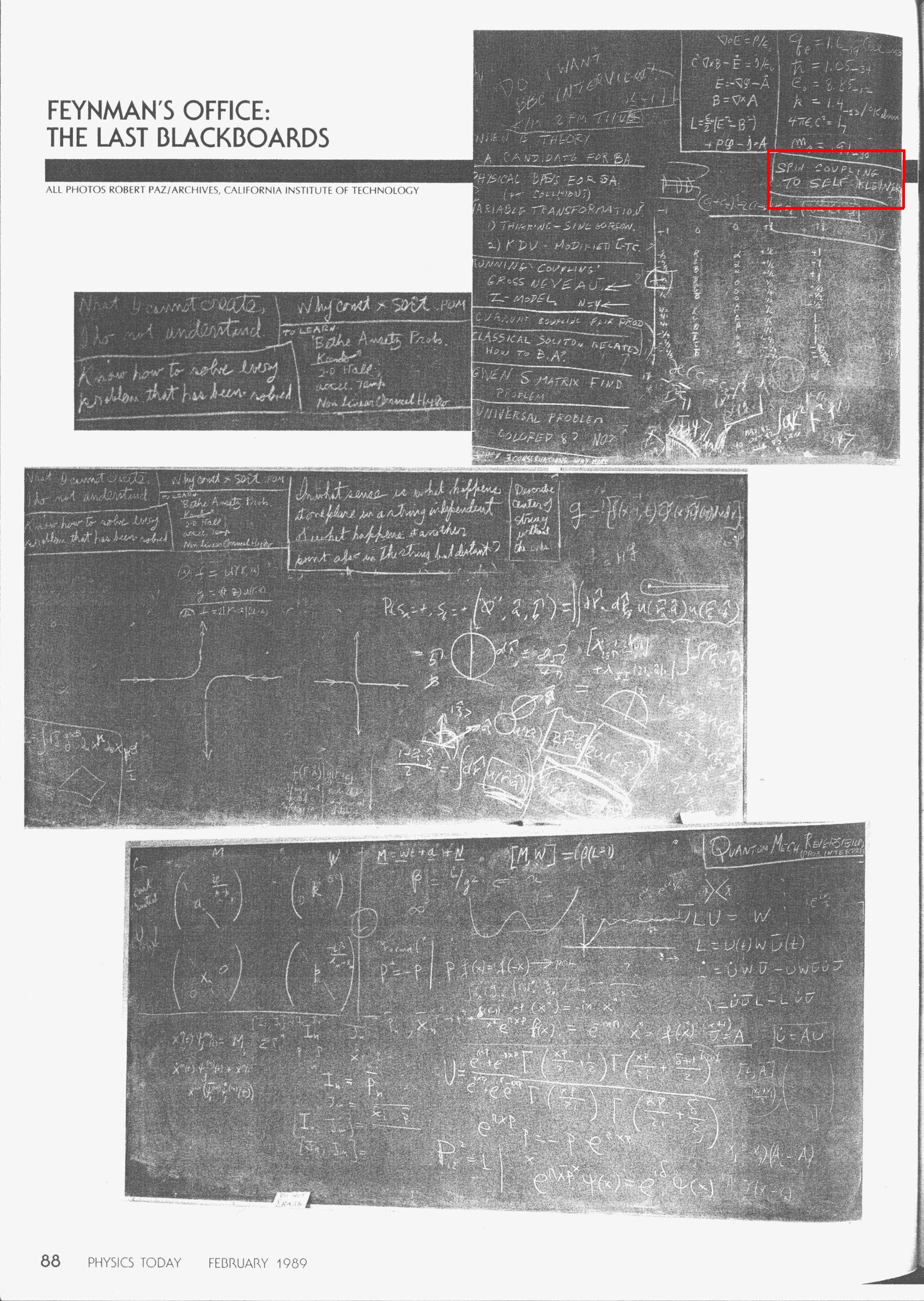
Fig. 1a: Feynman's last blackboard in Physics Today, February 1989 issue, p. 88.
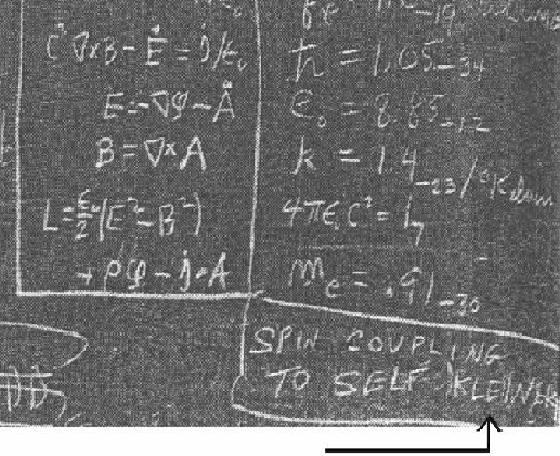
Fig. 1b: Feynman's last blackboard (zoom to the red frame shown in a)
Feynman's notes were always filled with lots of numerical calculations, with long columns of numbers obtained with the help of a pocket calculator. It reminded me of Riemann's notes, which are filled with such columns. Feynman told me that he liked to get numerical results. This was necessary back in the forties when working in Los Alamos on the Manhattan Project. At that time the machines were quite primitive by today's standards. Students often believe that great theoreticians design only abstract formulas and leave the calculations to others. But this is not so. Feynman always insisted in going to the end to get numbers, And when these did not fit the data, this was an important source of discoveries.
One of the set of notes which he showed me to in 1982 was easier to turn into physical results. These contained the variational calculations which are published in his 1972 Benjamin book on "Statistical Mechanics". Feynman suggested to me to work out a simple generalization, leading to what we called the effective classical potential. Fortunately, a simple cheap computer (the Sinclair ZX81, see Fig. 2) had become available a year earlier, and was just becoming very cheap in the supermarkets (15$ at Woolworth).
It connected to a television set and worked at a frequency of 3.25 MHz with a memory of 1 Kilobyte. With this little machine, I easily did the necessary calculations and wrote up the manuscript in Spring 1983. When I told him I had written up the paper Feynman came to visit me at the ITP in Santa Barbara to discuss the results. When he arrived everybody wanted to talk to him and he was pressed to give a seminar. He finally agreed, although he was not in good shape at that time. He began his talk with the words: "Sorry, that I am unprepared but I came here only to finish a paper with my friend Hagen". His talk dealt with the proliferation of vortex lines explaining the critical properties of superfluid helium. He had proposed this mechanism in a lecture in 1955, probably inspired by a similar proposal by Shockley in 1952 that the proliferation of defect lines should drive the melting transition. Both have probably known the pioneering 1949 paper by Onsager who had explained the phase transition of the two-dimensional Ising model by the proliferation of the line-like domain walls between up and down spins, and conjectured a similar mechanism for the vortex lines in superfluid helium. To his surprise, Feynman encountered strong but unjustified criticism from the young people in the audience who wanted to show that they were smart.
They had just learned to calculate critical properties by applying the renormalization group to complex scalar field theory, and did not believe that vortex lines were relevant. At that time, the disorder field description of superfluid helium was not yet common knowledge. These describe ensembles of vortex lines by fields whose Feynman diagrams are direct pictures of these lines. I had inroduced these fields in 1982 and published a full theory in a textbook in 1989 (Gauge Fields in Condensed Matter, Vols. I and II). After his talk and the fights, Feynman was extremely exhausted and disappointed by the aggressiveness of the audience. He lay down in my office and sighed "I should not have talked! Why am I doing this to myself?". When he returned to Caltech he felt quite ill and I was very worried. Of course, I did not dare to press him to go through our paper and permit me to send it off to a journal.
In February 1984 I returned to Berlin to my regular teaching duties, and forgot all about our manuscript, when in a night of May 1986 the telephone rang and Helen Tuck, Feynman's secretary, told me that Feynman found the paper OK as it was and wanted me to submit it to Physical Review A. It was interesting to observe the reaction of the referees to a paper with Feynman as an author: One wrote: "The manuscript shows the clarity and conciseness typical for Feynman's writing". The paper appeared in December 1986. Feynman never expected the method would be applicable to quantum field theory. However, I have found a way of doing this, and developed what I have named Field-Theoretic Variational Perturbation Theory .
-
The Peierls inequality was abandoned in order to deal with expansions of any order. This turns divergent weak-coupling expansions into convergent strong-coupling expansions. The convergence is mostly exponentially fast.
The details are described in Chapter 5 of my textbook Path Integrals in Quantum Mechanics, Statistics, Polymer Physics, and Financial Markets.
-
A simple trick was found to accommodate the anomalous dimensions of quantum field theory. The result is Field-Theoretic Variational Perturbation Theory which has led to the most reliable results of strong-coupling properties of field theories so far. The most-accurately measured strong-coupling property is the critical exponent that governs the singularity of the specific heat of superfluid helium, which was performed with great effort in a microgravity environment in a satellite by J. Lipa and collaborators . This experiment found precisely the value which I predicted in a seven-loop calculation. For details, see my textbook on this subject Critical Properties of phi4 Theories.
The relevant papers are:
- Strong-Coupling Behavior of Phi^4-Theories and Critical Exponents
- Critical Exponents from Seven-Loop Strong-Coupling $\phi^4$-Theory in Three Dimensions
- Strong-Coupling phi^4-Theory in 4 -- epsilon Dimensions, and Critical Exponents
- Critical Exponents without beta-Function
- Theory and Satellite Experiment for Critical Exponent alpha of lambda-Transition in Superfluid Helium
- Variational Resummation of epsilon-Expansions of Critical Exponents of Nonlinear O(N)-Symmetric sigma-Model in 2+ epsilon Dimensions
This led to the most reliable calculations of critical properties of systems near phase transitions so far. In particular, the most-accurately known singularity of the specific heat of superfluid helium which has been measured with great effort in a satellite experiment by J. Lipa and collaborators was precisely predicted, and I have written a textbook on this subject (Critical Properties of phi4 Theories).
Inspired by the collaboration with Feynman I published in 1990 the first edition of my textbook on Path Integrals in Quantum Mechanics, Statistics, and Polymer Physics which has become a real best seller. It also contains applications to financial markets. Without him, this book would have never appeared and many problems would have remained unsolved.
Another system we discussed many times was a stack of biomembranes. If they are contained between two walls they exert a pressure obeying a law very similar to the ideal gas law (Helfrich's law: p d^3=c T^2/k, where p=pressure, d=distance between the walls, T=temperature, k=stiffness of membranes). The challenge was to find the proportionality constant c which was only known from Monte-Carlo simulations. Unfortunately we could not find a solution at that time. The problem was not forgotten, however, and many years later I succeeded in solving it with the help of field-theoretic variational perturbation theory. Of all the physicists I have known, Feynman impressed me most with the simplicity and elegance with which he articulates and solves complicated problems. His course I attended was extremely clear. He never used camouflaging mathematical language to express physical facts. If someone did, he always stopped him with the question "what's that?", and insisted on a down-to-earth explanation. He never made the student feel stupid (unless he really was) and always explained his ideas to exhaustion. He was a perfect teacher. It is somewhat amazing that he has produced only a relatively small number of excellent postdocs of his own, in comparison with J.A. Wheeler or J. Schwinger. I guess the reason must be that too few students had the courage to approach him. Feynman has certainly shaped the thinking of all Caltech students who went through his classes even if they graduated with other thesis advisors. And, of course, the many students and colleagues around the world who have studied his fascinating textbooks on physics.
Documents on H. Kleinert's Collaboration with R.P. Feynman
-
This is Kleinert's and Feynman's joint paper:
Effective Classical Partition Functions
Phys. Rev. A 34, 6, 5080 (1986) -
Excerpt on this collaboration from the biography by John and Mary Gribbin:
"RICHARD FEYNMAN, A Life in Science", Viking, NY, 1997 - The article "Travailler avec Feynman" in the French journal POUR LA SCIENCE: download
- Printing errors in the book on path integrals by Feynman and Hibbs (collected by Tim Hatamian)
picture gallery
privacy policy
The protection of your privacy and your personal data is one of our highest priorities.
Responsible contact for any questions regarding our privacy policy:
Michael Kästner, Liebensteinstr. 6, 14195 Berlin, GERMANY
When you access this website through your web browser, the data of your specific request is submitted to our systems. The data contains the requested web page, the type of your web browser, your computer's operating system, the hostname of your internet service provider, and your current internet protocol address (IP address). The data itself does not allow a direct reconstruction of who you are. However, collecting the data is technically required to deliver the content of the page you requested to you. This is how the internet works. Since the protection of your privacy is one of our highest priorities, your data is not stored in a permanent way on our systems. All your data is deleted after delivering the requested content to you. Since the data is not stored on a hard disk, and just kept in our system's memory for the short time of your request, it becomes unlikely that, e.g., in the worst case of a successful cyber attack, your data may be compromised.
Transport encryptionAll the data exchanged between your web browser and our systems is protected by modern encryption technologies (TLS).
When is your data deleted?We collect data that is necessary to process your request and deliver the content to your web browser. The data is deleted immediately after the connection between your web browser and our systems is closed.
Your rights of informationYou have the rights to be informed about all your data that is stored on our systems. Furthermore, you have the rights that we change or delete your data upon your request.
Changes to our privacy policyThis privacy policy may be changed in the future to always fulfill the laws. In any case, for each request of our website the currently valid privacy policy may be found on this page.



































